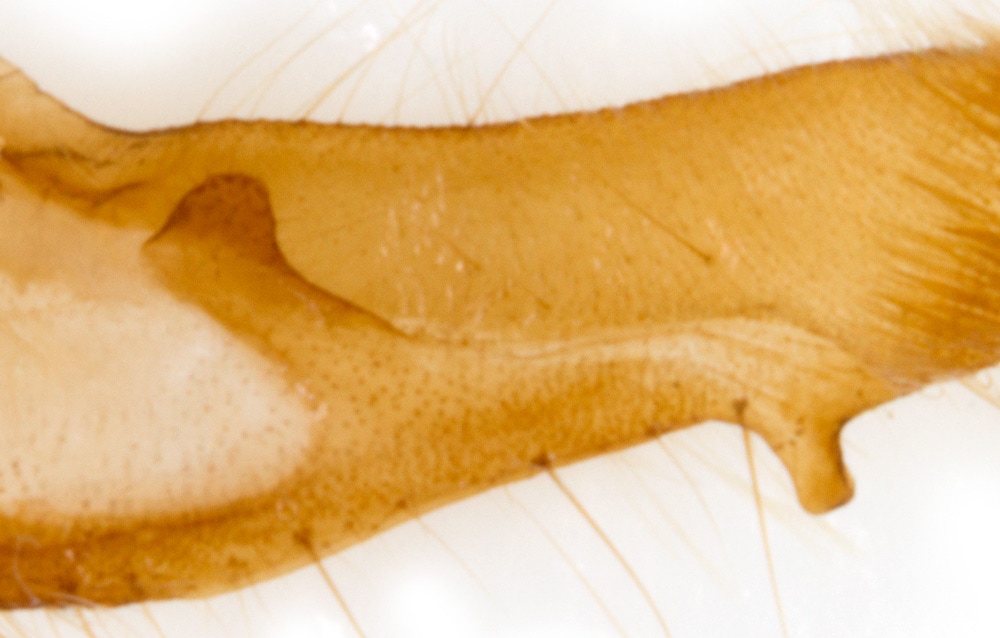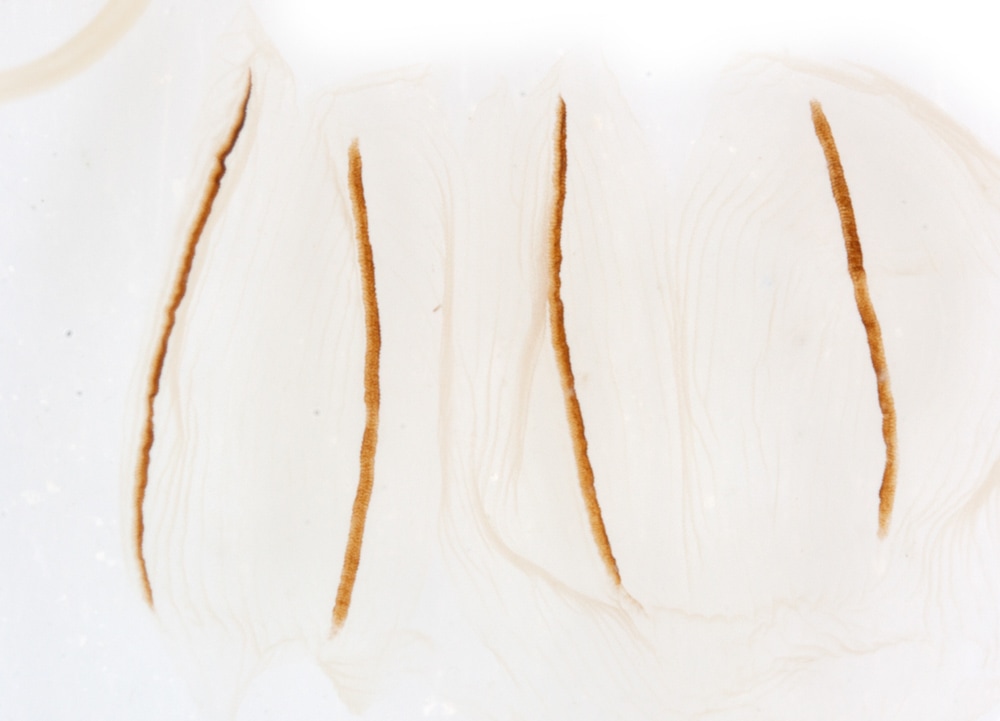Xestia ditrapezium (Triple-spotted Clay) vs Xestia triangulum (Double Square-spot) |
Both species are the same size (fw 17-19mm) and both fly June to early August. X.triangulum is more common and more widespread than X.ditrapezium. Both have the same basic pattern of forewing markings: a pale basal line bordered proximally by two black dashes and distally by a black blotch opposite the more dorsal dash; a pale antemedian line bordered distally by a black line and sometimes finely edged proximally by a black line; a pale curved postmedian line running through a fine dentate dark line*; an indistinct pale subterminal line with a variable darker proximal shade and a short bold black bar along its proximal border near the costa; a pale outlined narrow kidney mark; a broad black streak in the centre of the wing between the antemedian line and the proximal border of the kidney mark and completely or almost completely interrupted by the oval mark so that it appears as two black 'squares'. There does not seem to be any logic to either the English or scientific names of these two species and any attempt to identify them on the assumption that there is any logic to them will result in confusion and error.
In the guide to separating these species below features for X.ditrapezium are given first and images for X.ditrapezium are on the left.
* MBGBI9 interprets the antemedian and postmedian lines as being 'pale-edged', implying that it is the darker marking that is the 'line'
In the guide to separating these species below features for X.ditrapezium are given first and images for X.ditrapezium are on the left.
* MBGBI9 interprets the antemedian and postmedian lines as being 'pale-edged', implying that it is the darker marking that is the 'line'
Forewing
1. Ground colour: reddish-brown to purplish-black vs pinkish-brown to ochreous-grey
2. Wing breadth - narrower vs broader - but this difference does not seem sufficient to be diagnostic
According to MBGBI9 the forewing of X.ditrapezium is more heavily suffused with fuscous. I have not yet identified sufficient specimens of X.ditrapezium to confirm a useable difference - but - in all my specimens of X.triangulum the area between subbasal and antemedian lines is hardly suffused with fuscous, such that this area is either paler than the area distal to the antemedian line or concolorous; while specimens of X.ditrapezium show sufficient fuscous suffusion of the area between basal and antemedian lines that this area is usually darker than the area distal to the antemedian line.
1. Ground colour: reddish-brown to purplish-black vs pinkish-brown to ochreous-grey
2. Wing breadth - narrower vs broader - but this difference does not seem sufficient to be diagnostic
According to MBGBI9 the forewing of X.ditrapezium is more heavily suffused with fuscous. I have not yet identified sufficient specimens of X.ditrapezium to confirm a useable difference - but - in all my specimens of X.triangulum the area between subbasal and antemedian lines is hardly suffused with fuscous, such that this area is either paler than the area distal to the antemedian line or concolorous; while specimens of X.ditrapezium show sufficient fuscous suffusion of the area between basal and antemedian lines that this area is usually darker than the area distal to the antemedian line.
Forewing underside
Features mentioned in MBGBI9 are:
Glossiness: substantial vs not much
Fuscous suffusion: darker and extends to subterminal line vs not so dark and extends to postmedian line
Veins: pale vs inconspicuous
In my experience so far - the difference in fuscous suffusion appears to be reliable; glossiness is difficult to judge and the veins do not appear conspicuous in either species.
Features mentioned in MBGBI9 are:
Glossiness: substantial vs not much
Fuscous suffusion: darker and extends to subterminal line vs not so dark and extends to postmedian line
Veins: pale vs inconspicuous
In my experience so far - the difference in fuscous suffusion appears to be reliable; glossiness is difficult to judge and the veins do not appear conspicuous in either species.
Hindwing
According to Waring and Townsend X.ditrapezium has the hindwing "rather dark and brownish with orange-brown fringes" while in X.triangulum it is "uniformly grey with whitish or grey fringe". These descriptions seemed to me to provide an absolute distinction, but they are misleading in that it is quite easy to decide that the fringes of X.triangulum are orange-brown. Up to the time of writing, this has caused me to misidentify many specimens of X.triangulum as X.ditrapezium. MBGBI9 gives the following descriptions: X.ditrapezium: "Hindwing whitish, suffused grey-brown...; cilia pinkish-white, glossy" and X.triangulum: "Hindwing greyish-brown...; cilia pale pinkish-ochreous". Comparing the species MBGBI9 states that the hindwing of X.ditrapezium is "relatively paler".
I am as yet unconvinced that any hindwing upperside feature provides a reliable distinction between the species.
According to Waring and Townsend X.ditrapezium has the hindwing "rather dark and brownish with orange-brown fringes" while in X.triangulum it is "uniformly grey with whitish or grey fringe". These descriptions seemed to me to provide an absolute distinction, but they are misleading in that it is quite easy to decide that the fringes of X.triangulum are orange-brown. Up to the time of writing, this has caused me to misidentify many specimens of X.triangulum as X.ditrapezium. MBGBI9 gives the following descriptions: X.ditrapezium: "Hindwing whitish, suffused grey-brown...; cilia pinkish-white, glossy" and X.triangulum: "Hindwing greyish-brown...; cilia pale pinkish-ochreous". Comparing the species MBGBI9 states that the hindwing of X.ditrapezium is "relatively paler".
I am as yet unconvinced that any hindwing upperside feature provides a reliable distinction between the species.
Hindwing underside
Fuscous irroration: confined to costal region vs more evenly spread
Discal spot: smaller (~1mm diameter), dot-like or "slightly tailed posteriorly" vs larger (~2.5mm), V-shaped or triangular
These features are mentioned in MBGBI9 and appear to be subtle but reliable
Fuscous irroration: confined to costal region vs more evenly spread
Discal spot: smaller (~1mm diameter), dot-like or "slightly tailed posteriorly" vs larger (~2.5mm), V-shaped or triangular
These features are mentioned in MBGBI9 and appear to be subtle but reliable
note: on the underside of both the forewing and the hindwing of the specimens shown on this page the postmedian line curves to reach the costa more proximally in X.triangulum. I have yet to determine whether this is a constant difference between the species
Male genitalia:
1. Juxta - with a pointed apex vs with a rounded apex
2. Clasper - ends with a distinct long 'foot', clasper as a whole appears distinctly angled vs ends in a short 'foot', little angulation
3. Aedeagus - with a small apical tooth on the ventral (concave) surface vs without this tooth
1. Juxta - with a pointed apex vs with a rounded apex
2. Clasper - ends with a distinct long 'foot', clasper as a whole appears distinctly angled vs ends in a short 'foot', little angulation
3. Aedeagus - with a small apical tooth on the ventral (concave) surface vs without this tooth
Female genitalia
1. Ostium - a shallow incision in the subgenital plate vs a deep cleft in the subgenital plate
2. Signa - scobinate vs not scobinate?
The genitalia of both species are described and illustrated by Pierce (1942); only X.triangulum is shown at Moth Dissection. Pierce describes as follows - X.ditrapezium: "Ostium indent, clothed with fine spines. Signa 4, band-like, scobinate" and includes this species in a group "without deeply cleft plates"; X.triangulum: "Ostium between two serrate plates. Signa 4, band-like, not scobinate" and includes this species in a group with the "ostium between two dentate plates". However the Moth Dissection image of X.triangulum does not show any serration of the subgenital plate, nor do my images of this species, and the illustration in P&M also does not show any serration. With regard to the signa - at this stage I am unclear how helpful a difference between scobinate and not scobinate may be.
The depth of the ostium appears to be a reliable feature, extending to ~½ the length of the subgenital plate in X.ditrapezium and to at least ¾ in X.ditrapezium.
1. Ostium - a shallow incision in the subgenital plate vs a deep cleft in the subgenital plate
2. Signa - scobinate vs not scobinate?
The genitalia of both species are described and illustrated by Pierce (1942); only X.triangulum is shown at Moth Dissection. Pierce describes as follows - X.ditrapezium: "Ostium indent, clothed with fine spines. Signa 4, band-like, scobinate" and includes this species in a group "without deeply cleft plates"; X.triangulum: "Ostium between two serrate plates. Signa 4, band-like, not scobinate" and includes this species in a group with the "ostium between two dentate plates". However the Moth Dissection image of X.triangulum does not show any serration of the subgenital plate, nor do my images of this species, and the illustration in P&M also does not show any serration. With regard to the signa - at this stage I am unclear how helpful a difference between scobinate and not scobinate may be.
The depth of the ostium appears to be a reliable feature, extending to ~½ the length of the subgenital plate in X.ditrapezium and to at least ¾ in X.ditrapezium.
























